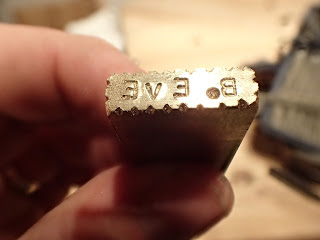The videos are not highly edited, but that is part of the charm. He just turns his camera on and lets it go. I find it adds an air of reality when he takes a minute to run across the shop to root around in a drawer for a tool that he wants to show.
 |
| My practice bit of pine. Looks like I need more practice, but this is promising. |
Recently, he did a video about making your own maker's stamp "on the cheap." Here is his video if you want to watch:
The biggest special tool for this was a set of 3/32" reverse letter punches. I bit the bullet and ordered a whole set. Used ones go on eBay every once in a while, and Young Brothers actually sells them individually, if you don't want to spring for the whole set. You just have to find a retailer who will work with you.
Brass is another story. David says not to go buy some especially for this project, because it is expensive. However, I did find some 360 brass at McMaster-Carr that was less than $20. It is 1/4" thick, two inches wide, and six inches long. I should be able to get three or four stamps out of this, at least.
 |
| Raw material. |
 |
| Filed one edge clean. |
 |
| This photo sponsored by Right Guard. |
 |
| It's supposed to say "B. EVE," not "Bo EVE." A little less heavy handed next time. |
 |
| It's backwards, because it is a stamp. Hopefully, it will spell what I want it to when I bash it on a piece of wood. |
 |
| Ugly, but functional. |
The wood I used to try this out on was some scrap pine I have around. I found out that it is a lot harder to get a good stamp in hardwood. For the most part, however, I am happy. It only took about 20 minutes, beginning to end, so there is no reason I couldn't make a prettier one now that I've done a rough one. I could saw the letters off of this one and use the same blank if I want to redo it, or I could make another one that says, "Munich," to use in conjunction with this one.
I think over time the brass will mushroom and distort on the end that meets the hammer, but I expect this stamp should last many years. Plus, it was such a simple thing to make.
The hardest part is figuring out the best way to make a nice, clear stamp, as there are no do-overs on a completed plane!



























